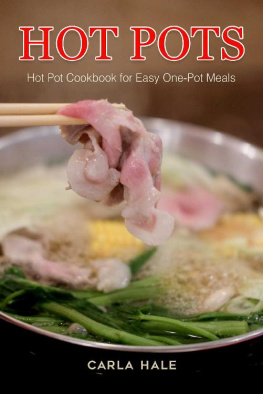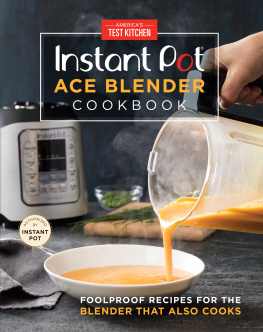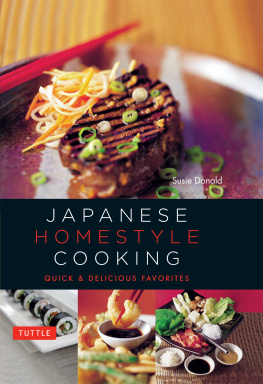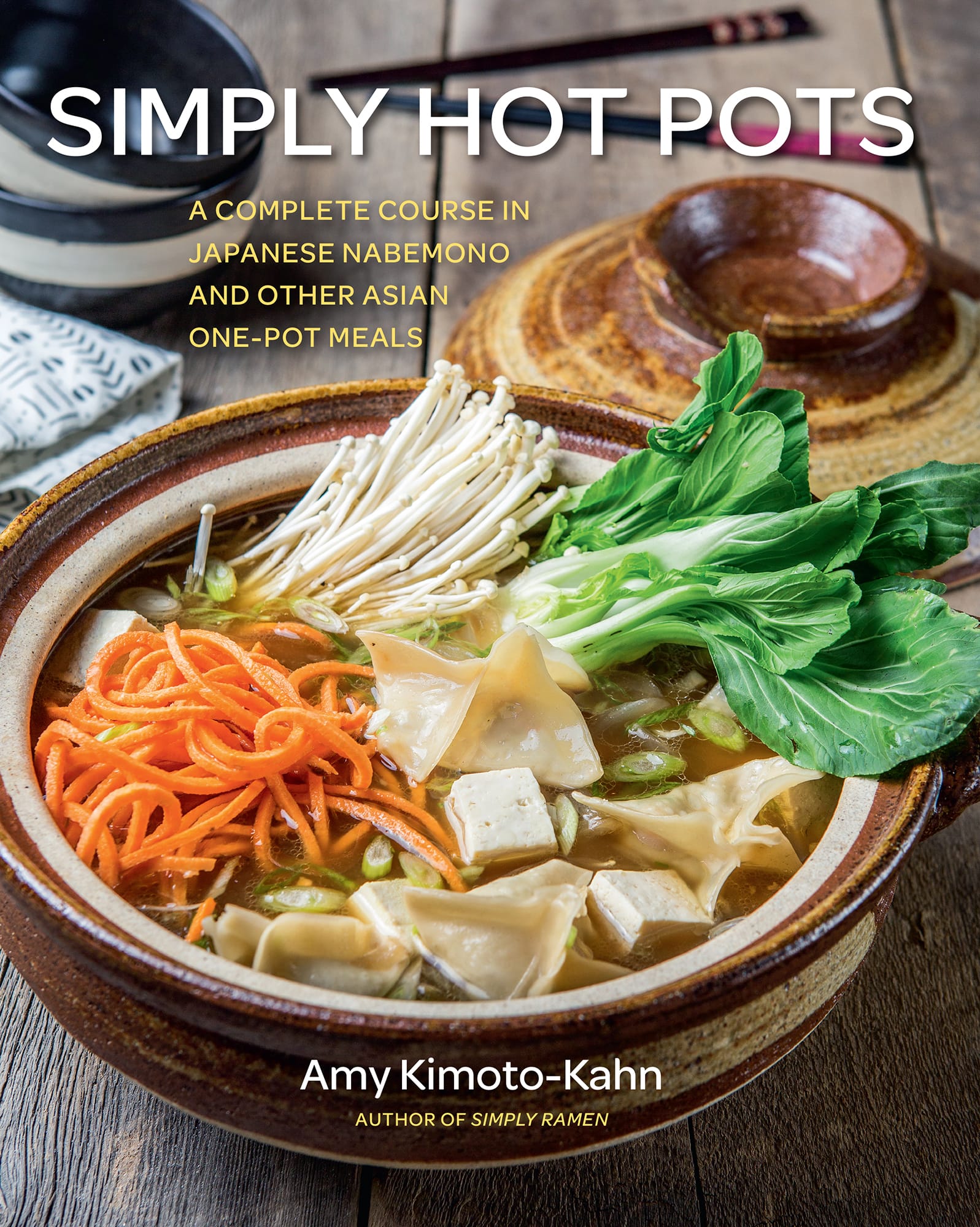SIMPLY HOT POTS
A COMPLETE COURSE IN JAPANESE NABEMONO AND OTHER ASIAN ONE-POT MEALS
Amy Kimoto-Kahn
AUTHOR OF SIMPLY RAMEN

PREFACE
I was born and raised with my two older siblings in Fullerton, California, in Orange County. My sister, Kathleen, and brother, Scott, are the book-smart ones. I, on the other hand, took the more social route and spent time pretending to have my own cooking show in our backyard rather than studying. My love of cooking came from watching my mom throw fabulous dinner parties with her friends; as I got older, I practiced her techniques and cooked for friends and family on my own. Im not a professionally trained chef, but Ive been cooking for more than thirty years. My mom shared her love of cooking with a close group of female friends, and together they created original recipes and hosted elaborate dinner parties, all while managing their own careers and raising children. They call themselves The Dames. Their storyand the reason I have such a passion for sharing good food (and really just throwing a good party)should be told.
Im a yonseia fourth-generation Japanese-American. My parents were both born in California. My mom, Yvonne, is from San Francisco, and my father, Hayato, is from Los Angeles. In 1941, just two months after the Japanese bombing of Pearl Harbor, all people of Japanese ancestry in the United Statesbe it 100 percent or /th percentwere forced into internment camps. Its not talked about in American history a lot, nor is it part of the core curriculum taught in schools today, but two-thirds of the more than 120,000 people who were interned and accused of being potential Japanese spies were American-born citizens, just like my parents. Both my parents and their families were given ten days to pack up only what they could carry and leave their homes.
My mom remembers the years immediately after her family was released from Amache camp in Colorado. People would throw rocks at her and her sister and brother and call them Japsan ethnic slur after the war. Money was tight. My grandmother went to work as a seamstress, and my grandfather eventually went to work for the same Japanese import-export business he had worked for before the war. They grew vegetables in their garden. My mother and her sister learned how to cook and stretch their available food for days. Fried rice, considered a Japanese peasant dish made from leftovers, was a family staple.
My father suffered similar prejudice after the war, with people spitting at him and calling him names. His family returned to the rougher area of East Los Angeles, where they were able to continue to operate their garment business. My grandfather had been a chef in San Francisco before the war, so he made Japanese dishes such as sukiyaki and shabu-shabu, even though his specialty was meringue cookies. My Auntie Alice sacrificed going to college to work with my grandmother, so the family could afford for my dad to attend the University of Southern California. It was there, while studying to be a pharmacist, that my dad met and fell in love with my mom, who was at USC for dental hygiene.

The Dames (My mom is in the second row, far left.).
During my parents time in college, there was still postwar prejudice, and they were excluded from joining social groups, such as sororities and fraternities. It was at USC that my mom decided to form her own group with her female Japanese-American friends, and thus, The Dames came to be. They were the Martha Stewarts of their time. They married, had children, and hosted elaborate gourmet evenings with menus including both Japanese and American dishes. The parties were hosted at different homes and the theme changed for each party. I have such clear memories of helping set the tables with fine china and silver, assisting Mom at the kitchen counter and chipping in with the dishes. It was an initiation of sorts.
Without realizing it, I had absorbed so much information from Mom and her friends that they still, to this day, inspire how I cook for my family and friends. I remember having lemon sorbet for the first time and learning it was not, in fact, a dessert, but a palate cleanser between courses. That early taste memory was the inspiration for my (I definitely encourage you to have it for dessert). I learned quickly that in Japanese cooking, its very important to eat with your eyes. In our culture, food presentation is just as important as preparation. I learned to make colorful dishes that were pleasing to look at and delicious. The Dames taught me that sometimes the finishing touch was garnishing a dish with a sprig of heavenly bamboo from our garden or adding a gardenia and some greenery to a dessert tray. When you looked at the food spread across the table, it made you feel special, like you were part of a secret club eating at one of the nicest restaurants in town.
While working on my first cookbook, Simply Ramen, I started gathering ideas from a cookbook The Dames wrote back in 1992. It is such a testament to their time (youll find baby back ribs next to beef shabu-shabu) that its now sold at the Japanese American National Museum in Los Angeles. The recipes are easy to follow with accessible ingredients and a perfect amalgam of Japanese and American cultures. In that book, I explored and highlighted both traditional and nontraditional ways of making ramen. Simply Hot Pots follows this same format, giving you the foundation to make traditional Japanese nabe (hot pots) with twelve basic broth recipes and also embracing international explorations of hot pots. Some recipes use a classic Japanese broth, but it might be put to use in a modern way, such as my an ode to my Jewish mother-in-law.
I am so pleased to be able to continue to share family recipes in this book along with recipes graciously developed and given to me by friends. Some of my favorites include my friend Emilys juicy and tender .
Please join me on my continuing journey to preserve my family history through food, and thank you for letting me show you how to make nabe in your own home. Although I may not know you personally, we are now connected through food. Enjoy!
Amy Kimoto-Kahn
INTRODUCTION
What is hot pot cooking? Its about bringing people together. Its comfort food. Its healthy, affordable, quick, and easy. Its a complete one-pot meal that can be customized for anyone. Hot pot cooking embodies Japanese culture with its use of fresh, seasonal ingredients, delicate presentation, and the humble manner in which it is served. In Japan, hot pots are called nabemono (nah-beh-mo-no), or nabe for short. The stout, clay, lidded pots that nabe are cooked in are called donabe (doh-nah-beh; directly translated, nabe means pot). They have not changed in thousands of years and continue to be a fixture in todays Japanese kitchen.











